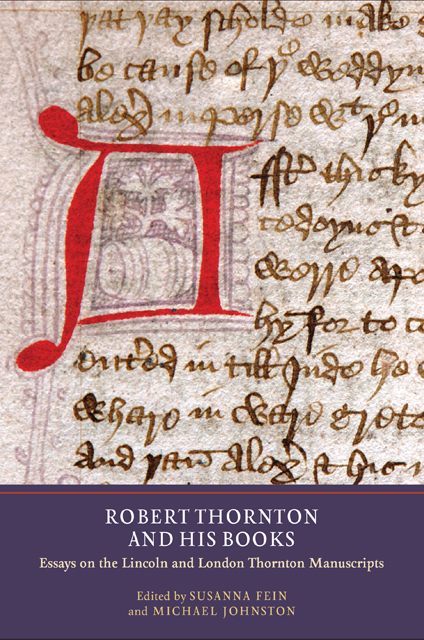Book contents
- Frontmatter
- Contents
- List of Illustrations
- List of Contributors
- Acknowledgements
- Abbreviations
- Introduction: The Cheese and the Worms and Robert Thornton
- 1 The Contents of Robert Thornton’s Manuscripts
- 2 Robert Thornton: Gentleman, Reader and Scribe
- 3 The Thornton Manuscripts and Book Production in York
- 4 The Text of the Alliterative Morte Arthure: A Prolegomenon for a Future Edition
- 5 ‘The rosselde spere to his herte rynnes’: Religious Violence in the Alliterative Morte Arthure and the Lincoln Thornton Manuscript
- 6 Constantinian Christianity in the London Thornton Manuscript: The Codicological and Linguistic Evidence of Thornton’s Intentions
- 7 Apocryphal Romance in the London Thornton Manuscript
- 8 Thornton’s Remedies and the Practices of Medical Reading
- Afterword: Robert Thornton Country
- Bibliography
- Index of Manuscripts Cited
- General Index
- York Medieval Press: Publications
4 - The Text of the Alliterative Morte Arthure: A Prolegomenon for a Future Edition
Published online by Cambridge University Press: 28 February 2023
- Frontmatter
- Contents
- List of Illustrations
- List of Contributors
- Acknowledgements
- Abbreviations
- Introduction: The Cheese and the Worms and Robert Thornton
- 1 The Contents of Robert Thornton’s Manuscripts
- 2 Robert Thornton: Gentleman, Reader and Scribe
- 3 The Thornton Manuscripts and Book Production in York
- 4 The Text of the Alliterative Morte Arthure: A Prolegomenon for a Future Edition
- 5 ‘The rosselde spere to his herte rynnes’: Religious Violence in the Alliterative Morte Arthure and the Lincoln Thornton Manuscript
- 6 Constantinian Christianity in the London Thornton Manuscript: The Codicological and Linguistic Evidence of Thornton’s Intentions
- 7 Apocryphal Romance in the London Thornton Manuscript
- 8 Thornton’s Remedies and the Practices of Medical Reading
- Afterword: Robert Thornton Country
- Bibliography
- Index of Manuscripts Cited
- General Index
- York Medieval Press: Publications
Summary
Editing Thornton’s text
In one of the earliest publications of the nascent Early English Text Society, the alliterative Morte Arthure brought Robert Thornton’s miscellany, Lincoln Cathedral Library, MS 91, to critical attention. It was the alliterative poem most frequently edited in the late nineteenth and early twentieth centuries, and it has retained its cachet as the poetic centrepiece of Thornton’s scribal oeuvre. At this time, the editio receptus of this impressively moving work remains Mary Hamel’s treatment of the poem, now thirty years old.
Hamel’s edition has been justly praised. She offers some important innovations in considering the poem’s sources. However, her achievement is less happy as editorial work. As her statements about procedures indicate, Hamel conceptualizes her task as that of a person defending the plausibility of Thornton’s transcription, not, as editors conventionally do, as one engaged in a critical investigation of that transcription. Thus, the edition provides a good introduction to what Thornton copied, which is not necessarily what the poet wrote. Although her commentary is valuable, explanations of the received text are not always provided.
From this retrospect, furthermore, Hamel’s edition suffers from its timing. Her work was produced prior to two important scholarly interventions which might have inspired her to offer somewhat differing results from those printed; these we intend here to examine in turn. The first of these was the publication of the broadest available conspectus of Middle English usage, in the Aberdeen dialect atlas; the second, Hoyt N. Duggan’s important series of articles on those constraints governing alliterative metrics. We begin by addressing the effects that these have on Hamel’s presentation and on our understanding of the Morte more generally.
The Morte, as Hamel points out, has long been associated, not with the ‘home of alliterative poetry’ as conventionally recognized, the north and west, but with Lincolnshire. This view was first argued in 1962 by Angus McIntosh, who asserted that Thornton’s forms overlay two other linguistic layers. The oldest of these, in McIntosh’s account, represents the language of somewhere near Louth (in Lindsey, northeast Lincolnshire). He localized the linguistic layer intermediate between this and Thornton’s copying in Kesteven, in the south-west of the county, ‘between Sleaford and Grantham’.
- Type
- Chapter
- Information
- Robert Thornton and his BooksEssays on the Lincoln and London Thornton Manuscripts, pp. 131 - 156Publisher: Boydell & BrewerPrint publication year: 2014
- 2
- Cited by



